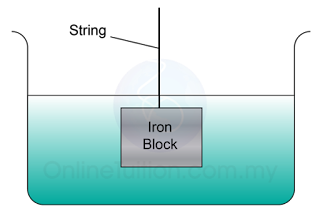Diagram (a) above shows a metal block supported by a spring balance. Diagram (b) shows the block partially immerses in water while diagram (c) shows the block fully immerses in water.
- What is the mass of the metal block?
W = mg
(20) = m(10)
m = 2kg - In diagram b), the reading of the balance became 14N.
- What is the effective weight loss of the block when partially immense in water as shown in diagram (b)?
Weight loss = 20 – 14 = 6N
- What is the value of the upthrust that act on the block?
6 N
- Find the weight of the displaced water?
6 N
- In diagram c), when the block is fully immerse in water, the reading of the spring balance became 10N.
- Name 3 forces that acted on the block.
Weight, tension of the string, upthrust
- State and explain the relationship between the forces in (c) (i)
Both the tension and the upthrust act upward, the weight acts downward. The block doesn’t move. Therefore, all forces are in equilibrium.
Weight = Tension of the String + Upthrust
- Find the volume of the block. [Density of water = 1000 kg m-3]
Mass of the displaced water = 1 kg
- Name the principle you used in the calculation in question (c) (iii).
Archimedes’ Principle
- What will happen to the reading of the spring balance if the water is replaced with cooking oil.
Increase
- Explain your answer in (c) (v)
The upthrust produced is directly proportional to the density.
The cooking has lower density. Therefore the upthrust produced is lower. As a result, the weight loss caused by the upthrust will decrease and the reading of the spring balance will increase.
























